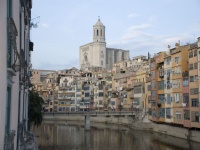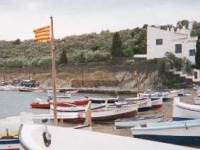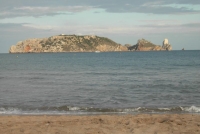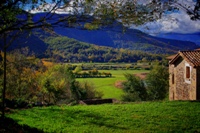Costa Brava Travel Guide
The ruggedly beautiful Costa Brava holiday coast stretches for 100 miles (160km) along the shores of Catalonia in Spain's northeastern corner, from Port Bou on the Franco-Spanish border to Tossa del Mar, just north of Barcelona. Though filled with high-rise resort developments and modern marinas catering to package tourists, the coast retains enough coves, caves, green hillsides and lonely, wild cliffs to belie its reputation as one of Europe's busiest holiday destinations.
Holidaymakers revel in the hidden delights of the craggy coastline, with many venturing out in boats to discover deserted coves scented with pine and citrus trees, fragrant herbs and bright flowers. Popular resorts and marinas lie in close proximity to relatively unspoilt fishing villages and towns. Some old castles and fortifications showcase the area's rich history; offshore divers will find an abundance of wrecks to explore in the crystalline waters, while seemingly endless sunshine pours down on stretches of sandy or shingle beach.
The undeveloped natural areas and fishing industry have also resulted in making a holiday here a gastronomic treat. Seafood reigns supreme, from sardines to delicious lobster, but specialities include local wild game,such as boar, duck and rabbit, which can all be washed down with a variety of wines produced from the vineyards that clothe the hillsides.
Things to do in Costa Brava
The allure of the Costa Brava is the combination of crowded, manicured resorts and rugged unspoilt coastline, which offers tourists the best of both worlds through great amenities and luxury, as well as natural beauty. There are a number of Blue Flag beaches along the Costa Brava, and also some secluded, rocky coves.
The glorious beaches, in combination with the renowned food and restaurant scene, makes the Costa Brava ideal for resort holidays, with the most popular destinations including Roses, Lloret de Mar and Blanes. Tossa de Mar, a smaller, more authentic coastal resort village, is also a delight, and the bigger centres of Girona and Banyoles offer many attractions.
Visitors will find wonderful coastal walks and numerous golf courses, as well as many fun water sports, and there's quality cultural and historical sightseeing for those who are interested. Attractions include some impressive Roman and Iberian archaeological sites. The extensive ruins of the ancient Greco-Roman city, Empuries, is the highlight for many visitors.
The nearby medieval village of Sant Marti d'Empuries is also lovely to explore. Lastly, Costa Brava is Dali country and there are three museums to visit for fans of the artist, including the fascinating Salvador Dali Museum House near Cadaques.

Girona
The city of Girona, on the route from the Pyrenees to Barcelona, is one of the most important historical sites in Spain, and was founded by the Romans and later turned into a Moorish stronghold. Sitting astride the confluence of the Onyar and Ter rivers, this quaint medieval city attracts hordes of tourists from the Costa Brava resorts and Barcelona. All are lured by the experience of walking through the old quarter, the Call, with its narrow alleyways and ancient stone houses. Inside the ancient walls, visitors will find gems such as the 12th-century Benedictine monastery of Sant Pere de Galligants and the 14th-century cathedral built in the Catalonian Baroque style. The cathedral can be accessed by climbing up 90 steps. It includes a museum that contains art works and rare manuscripts.

Salvador Dali Museum House
The busy fishing village of Cadaques draws plenty of visitors, but they don't come for the local beach, which is rather narrow and stony. Rather, the resort town's attractions are its picturesque natural harbour, some excellent restaurants, numerous galleries, fashion, and art and craft shops, and the former home-turned-museum of world-renowned surrealist painter, Salvador Dali. Situated in nearby Portlligat Bay, Dali's bizarre home consists of a labyrinthine cluster of fishermen's huts that were added to the original building in various stages by the artist over a period of 40 years. Visitors must reserve a time for entry in advance as only about eight people are allowed in the museum at a time.

The Medes Islands
Situated scarcely a mile from the beach of the popular resort town of L'Estartit on the Costa Brava, the protected Medes Islands are seen as heaven for divers. The craggy little archipelago of seven islets and a few reefs form one of the most important and rich marine reserves in the Mediterranean. Meda Gran, the largest of the islands, is the only one of considerable size, and there's a 10th-century lighthouse on it. Most of the islands are just rocky outcrops jutting out of the sea, with little vegetation. However, the magic happens underwater, where millions of fish and thousands of animal and plant species inhabit the shallows, crevices and submarine caves at the base of the island cliffs.

Garrotxa Nature Reserve
Visiting the dormant volcanoes is not one of the typical things to do in Spain, yet they offer stunning scenery and a one-of-a-kind experience. Sandwiched between the Pyrenees and Costa Brava, the region of Garrotxa is home to a multitude of prehistoric volcanoes as well as many castles and country houses. Visitors who want to experience more of Spain than the quintessential beach and city breaks should head to Garrotxa Nature Reserve just outside of Girona, where they can explore a land of amazing and rugged landscapes, fire and ash. The reserve showcases the best of rural tourism in Spain and is perfect for enthusiastic hikers.
Spain travel info
Electricity
The electrical current is 230 volts, 50Hz. European-style two-pin plugs are standard.
Language
Spanish is the official language, but English is widely understood in areas frequented by tourists. Catalan, Galician and Basque are spoken in the relevant areas.
Money
Spain's official currency is the euro (EUR), which is divided into 100 cents. Money can be exchanged at bureaux de change and major hotels, but banks give the best rates. All major credit cards are widely accepted at most hotels, restaurants, and shops. ATMs are widespread and are generally the cheapest and most convenient method of obtaining money.
Tipping
Hotel and restaurant bills usually include service charges, but additional tips are welcomed for services rendered. In established restaurants, tips of about 10 percent are expected. Drivers of metered taxis expect small tips and it's customary to tip about 5 to 10 percent for most services, including guides.
Health
There are no health risks associated with travel to Spain, and no vaccination certificates are required for entry. Medical facilities are good but comprehensive travel insurance is always advised. Spain has a reciprocal health agreement with most EU countries that provides emergency health care for EU travellers on the same terms as Spanish nationals. After Brexit, the Global Health Insurance Card (GHIC) replaced the European Health Insurance Card (EHIC) for UK citizens. The GHIC allows UK citizens access to state healthcare during visits to the EU. The GHIC is not valid in Norway, Iceland, Liechtenstein or Switzerland, nor is it an alternative to travel insurance. EU travellers should take a European Health Insurance Card (EHIC). Travellers should take any medication they require along with them, in its original packaging and accompanied by a signed and dated letter from a doctor detailing what it is and why it is needed.
Safety
Most visits to Spain are trouble-free except for occasional street crime. Petty crime, such as pickpocketing and purse snatching, is most common in larger cities, particularly during holidays, festivals and weekends, and especially on public transport and in tourist areas. Thieves may work alone or in groups; visitors should be wary of strangers who offer or ask for help of any kind, or inform them of a stain on their clothes, as these are often ways of providing a distraction for accomplices. There are also scams involving letters for outstanding traffic fines or Spanish lottery winnings. Travellers can avoid incidents if they exercise all the normal precautions.
Local customs
Smoking in public places is banned and stiff fines will be imposed for smoking in areas such as enclosed public spaces, areas where food is prepared and sold, public transport, non-smoking areas of bars and restaurants, and any places that cater for children. Drinking alcohol in the streets of Madrid and the streets of the Canary and Balearic Islands is illegal.
Doing business
The business culture in Spain is slowly shifting but, for now, it's entrenched in tradition and it can take some time for foreigners to gain a foothold in the Spanish working world. It's important never to undermine authority as hierarchy is central to Spain's business world. Managers tend to make decisions without considering input from their colleagues.
A strong emphasis is placed on social status, character attributes, and personal pride. Success is often hinged upon being well-dressed, honourable, and dignified, while also exhibiting great social skills. Business meetings are generally conducted face-to-face and can go on for long periods, as Spaniards prefer long deliberations in order to avoid uncertainty in corporate dealings. Business meetings in Spain tend to tread a fine line between personal and formal.
Conducting business in Spain can entail navigation through a lot of red tape and bureaucracy. Spanish is the language of business, but some of the larger multinationals conduct meetings in both English and Spanish. Business hours are often quite varied, but generally open by 9am and close in the mid-evening with a two-hour lunch break during the early afternoon.
Business attire is quite conservative with men wearing dark or linen suits, shirts and silk ties. Women should wear modest dresses or tailored suits. Brand names or labels attract affirmation from colleagues and associates.
After the conclusion of successful negotiations, gifts are appropriate. Gifts should be of high quality and, when receiving a gift, it should be opened in front of the giver. Business cards are important and should be bilingual. Meetings are best scheduled for mid-morning, and establishing a formal yet personable environment is important before beginning. Meetings often occur over lunches and dinners.
Duty free
Travellers from EU countries are allowed the following items duty free: 800 cigarettes or 400 cigarillos or 200 cigars or 1kg tobacco; 110 litres beer; 90 litres wine; and 10 litres spirit. Travellers from non-EU countries may have 200 cigarettes or 100 cigarillos or 50 cigars or 250g tobacco; 1 litre spirits, 4 litres wine, and 16 litres beer.
Communications
The international access code for Spain is +34. WiFi is widely available; travellers can purchase local SIM cards for unlocked phones or use eSIMs if their cellular providers support it on their networks.
Passport & Visa
The borderless region known as the Schengen area includes the following countries: Austria, Belgium, Czech Republic, Denmark, Estonia, Finland, France, Germany, Greece, Hungary, Iceland, Italy, Latvia, Lithuania, Luxembourg, Malta, The Netherlands, Norway, Poland, Portugal, Slovakia, Slovenia, Spain, and Sweden. All these countries issue a standard Schengen visa that has a multiple entry option, allowing the holder to travel freely within the borders of all. Non-EU nationals must hold a return or onward ticket, all necessary documents for onward travel and sufficient funds. It is highly recommended that passports have at least six months' validity remaining after the intended date of departure from Spain. Immigration officials often apply different rules to those stated by travel agents and official sources.
Entry requirements
United States citizens require a passport valid for three months beyond the period of intended stay. No visa is required for stays of up to 90 days within a 180 day period.
British citizens require a passport valid for three months beyond the period of intended stay. No visa is required for stays of up to 90 days within a 180 day period.
Canadian citizens require a passport valid for at least three months beyond period of intended stay. No visa is required for stays of up to 90 days within a 180 day period.
Australian citizens require a passport valid for at least three months beyond period of intended stay. No visa is required for stays of up to 90 days within a 180 day period.
South African citizens require a passport valid for at least three months beyond period of intended stay. A visa is required.
Irish nationals require a valid passport, but a visa is not necessary.
New Zealand citizens require a passport valid for at least three months beyond period of intended stay. No visa is required for stays of up to 90 days within a 180 day period.
Useful contacts
Spanish Tourist Office, Madrid: www.spain.info.
112 (General).


